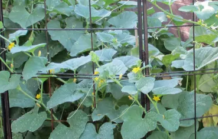Gardeners often try to get a jump on the season by planting tomatoes as early as possible. Though this can be successful, there are certain precautions that should be observed, especially this year with the abnormally cool spring.
Adequate soil temperature: Tomato roots do not do well until soil temperatures reach a fairly consistent 55 degrees F. Use a soil thermometer to check the temperature at 2 inches deep during the late morning to get a good average temperature for the day. Most soil temperatures in Kansas now are in the 40’s. Plastic mulch can be used to warm soil more quickly than bare ground. Purple leaves are a sign of phosphorus deficiency due to cool soils.
Harden off plants: Plants moved directly from a warm, moist greenhouse to the more exposed and cooler conditions outside may undergo transplant shock. Transplant shock causes plants to stop growing for a time. Plants can be acclimated to outside conditions by placing them outdoors in a location protected from wind and full sunlight for a few days before transplanting.
Another way to harden off plants is to transplant them and place a cardboard tent or wooden shingle to protect them from wind and sun for 2 to 3 days. The best conditions for transplanting is an overcast, still day.
Protection from frost: Tomatoes cannot tolerate frost. Though we are past the average date of the last frost in most of Kansas, watch the weather and cover the plants if frost threatens. A floating row cover or light sheets can be used for protection. Actually a floating row cover can be left on the plants for two to three weeks to increase the rate of growth and establishment.
Other tips for getting tomato plants off to a fast start include:
1. Use small, stocky, dark green plants rather than tall, spindly ones. Smaller plants form roots rapidly and become established more quickly than those that are overgrown.
2. Though tomatoes can be planted slightly deeper than the cell-pack, do not bury the plant deeply or lay the stem sideways unless the plant is very leggy. Though roots will form on the stems of tomatoes, this requires energy that would be better used for establishment and growth.
3. Use a transplant solution (starter solution) when transplanting to make sure roots are moist and nutrients are readily available.
4. Do not mulch until the plant is growing well. Mulching too early prevents soil from warming up. (Ward Upham)




